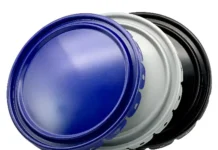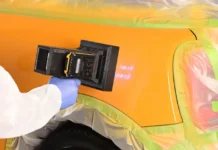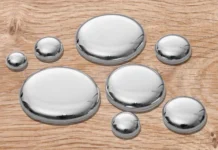The Importance of Controlling Coating Temperature in UV Applications
by Michael R. Bonner
Saint Clair Systems, Inc.
” title=”Figure 1″>
SUBMITTED
Figure 1
” title=”Figure 2″>
SUBMITTED
Figure 2
” title=”Figure 3″>
SUBMITTED
Figure 3
” title=”Figure 4″>
SUBMITTED
Figure 4
” title=”Figure 5″>
SUBMITTED
Figure 5
” title=”Figure 6″>
SUBMITTED
Figure 6
” title=”Figure 7″>
SUBMITTED
Figure 7
- This is part one of a two-part series of articles. The second part will publish in the 2017 Quarter 1 issue of UV+EB Technology.
In modern coating operations, temperature-related variations can result in significant quality problems with film build, color match, surface finish, gloss, adhesion, etc. This applies to UV cure coatings the same as it does to more conventional solventborne and waterborne systems. In this two-part article we will examine these similarities and how approaches developed for these conventional coating systems can be applied to UV coatings for even better results. Lets start with the intractable relationship between temperature and viscosity.
The fundamentals of temperature and viscosity
All liquids show some change in viscosity as a function of temperature. Figure 1, taken from an old viscometer data sheet1, shows that even water goes through a viscosity change of 2:1 between 10°C and 40°C (50°F to 104°F).
Modern coatings are no different. Figure 2 shows the viscosity vs. temperature curve for a common solventborne coating. This shows the typical nonlinear relationship associated with coatings over the normal ambient temperature range. It is worthwhile to note that this is shared with virtually all liquids and is a physical property, not a defect. As such, this is a parameter that can be exploited to improve the performance of the coating process.
The optimum coating viscosity for this material (26 ±2 seconds) is plotted on the graph to show its relationship to temperature. The entire acceptable viscosity range relates to a 3°C (5°F) window from 26.5°C to 29.5°C (80°F to 85°F). If the coating temperature is outside this narrow window, it will be outside of its optimal viscosity range, and either the viscosity must be corrected or other process parameters must be adjusted to compensate.
In a system without temperature conditioning, little can be done when the coating is above the 29.5°C (85°F) upper limit and the resulting viscosity is below the 24s lower limit. Other parameters (pressures, speeds, etc.) must be adjusted to compensate. More often, however, the coating temperature is below the 26.5°C (80°F) lower limit and the resulting viscosity is therefore above the 28s upper limit. The most common practice in this instance is to add solvent to reduce the viscosity of the coating.
Figure 3 shows the relationship between solvent addition and change in viscosity. Note that the relationship is relatively linear for the small range shown. From the graph we can see that a reduction of 10s will require the addition of just over 3 percent of solvent by volume, whereas a reduction of 15s will require the addition of nearly 5 percent. This amounts to 6l (1.5 gal) and 10l (2.5 gal) per 200l (50 gal) drum respectively. It is important to note that every ounce of this solvent will be driven off in the oven as the coating is cured and so represents excess cost in the process. In addition, too much solvent can cause such issues as blister and pop, orange peel, low gloss and even off-color. Therefore, minimizing solvent addition is a worthwhile objective.
To correlate temperature to solvent addition, we return to the viscosity vs. temperature graph appearing again as Figure 4. Here we can see that a 4°C increase in temperature from 16°C to 20°C (61°F to 68°F) produces a 15s reduction in viscosity. Likewise, the next 5°C, from 20°C to 25°C (68°F to 77°F), produces an additional 10s reduction in viscosity. Therefore, this 9°C (16°F) change in temperature has the same effect as adding 16l (4 gal) of solvent to a 200l (50 gal) drum (8 percent).
An important, but often misunderstood fact regarding viscosity is that every coating formulation has its own temperature/viscosity relationship. This is why the product data sheet for virtually any given formulation provides a reference viscosity, often specified at 25°C (77°F). Figure 5 shows the plots for seven colors, all of the same resin base type, and formulated for the same application. Contrary to popular belief, these identical coatings display a range of viscosities from 21 to 31 seconds at 25°C (77°F) and each varies quite differently over the 10°C to 35°C (50°F to 95°F) temperature range. To obtain acceptable performance from each color, there must be either changes in the setup parameters of the application system to compensate for these viscosity variations, or the coating must be consistently delivered to the point-of-application at its optimal temperature.
Enter 100 percent solids UV cure coatings
The recent introduction of 100 percent solids, UV cure coatings has been hailed as a means to reduce solvent use and to allow coating of substrates such as wood and plastic that cannot be oven-cured. From a processing perspective, however, these are little different from their solventborne counterparts. Chemically, these are comprised of an oligomer resin that is quite viscous. To bring that viscosity down to a useable range, a monomer reducer is added. Figure 6 shows the curves for a typical UV cure coating in its pure state, and when blended with reducer at 70/30 and 50/50 ratios.
Figure 6 shows the high viscosity of the resin and the dramatic effect of temperature on that viscosity. In order to allow easy comparison to the solventborne coatings above, it has also been converted to Zahn 4 seconds. Looking only at the normal ambient range of 20°C to 40°C (68°F 104°F), the solventborne coating in Figure 2 above displays a 2.5:1 change in viscosity, as compared to 10:1 for this UV resin. So immediately we can see that the UV coating is much more sensitive to changes in temperature than its solvent based counterpart. But in reality, it is far more dramatic than this comparison suggests. Looking at the data, we can see that the solventborne coating changes from a high of 40s at 20°C (68°F) to 16s at 40°C (104°F). In contrast, the UV resin changes from a high of 2300s at 20°C (68°F) to 230s at 40°C (104°F).
Also, as with its solventborne counterpart, the viscosity of the monomer reducer is orders of magnitude lower than the resin and so, has a significant downward influence on the viscosity of the blend. Though the reduced curves in Figure 6 appear quite flat, this is an optical illusion caused by the large linear vertical scale required to display the entire 100 percent oligomer curve. On closer examination, we find that these are all exponential curves and so are much easier to see and compare when we change to a logarithmic vertical scale as shown in Figure 7.
To further demonstrate the similarity between the characteristics of the two coatings, we will make the assumption that we are substituting the 100 percent solids coating in place of the solventborne coating in the same application and, in order to achieve the same performance from our application system, desire to have the same viscosity. If we place a line at 26 seconds on this graph, some interesting coincidences appear. First is that the 50/50 blend is at 26s at 20°C (68°F). Following our assumption, then, we can hold the 50/50 blend at 20°C and make a direct substitution into our process. But, as with solventborne coatings, the addition of reducer compromises the performance of the coating. In fact, the addition of monomer significantly changes the cure characteristics of the formulation as well as the chemical and physical properties of the resulting coating. This is because all of the monomer diluent remains in the coating matrix after the cure and this can be problematic, especially at this level. Therefore, as with solventborne coatings, the goal with UV coatings is to minimize the amount of monomer added, to both control costs and improve coating performance.
Moving to the right we find that, at 40°C (104°F), the 70/30 blend is also at a 26s viscosity. And so, we can hold the 70/30 blend at 40°C and make a direct substitution into our process. We can expect the performance to be greatly improved over the 50/50 blend due to the lower monomer content.
Finally, at the extreme, the 100 percent resin is at 26s at 70°C (158°F) and could be used without reducer at that temperature. Here, we would expect our best performance due to the minimization of monomer. Unfortunately, this is too hot for plastics and many of the more delicate substrates often identified as ideal candidates for UV cure coatings. Moreover, operating at such an elevated temperature would require special system design considerations to protect the operators.
The bottom line is that, in the 100 percent solids world, simple adjustments to modify rheology to fit requirements of various application methods or specific equipment characteristics are not as simple as hitting a viscosity window by adding a bit of solvent.
Though we have really only scratched the surface, this provides a good, functional understanding of the intractable interdependency between viscosity and temperature in modern coating materials, and the wide variations they create. From here, the next logical step is to look at their implications in application. In the second and final part of this article, the two most common application processes spraying and rolling are examined in detail. We also will explore how modern temperature control systems can be used to turn temperature from an adversary, out of our control, into a tool which we can utilize to assure that the outcomes of our coating process are predictable independent of changes in ambient temperature and/or processing conditions.
Bibliography
- Water Temperature vs. Viscosity data provided courtesy of Norcross Corporation.
- Paint Temperature vs. Viscosity data provided courtesy of Alsco Metals Corporation Roxboro, North Carolina.
- Material Viscosity vs. Solvent data provided courtesy of Alsco Metals Corporation Roxboro, North Carolina.
- Paint Viscosity vs. Temperature data provided courtesy of Sherwin-Williams Corporation.
Michael R. Bonner is the vice president of engineering & technology for Saint Clair Systems, Inc., a supplier of process temperature control equipment for industrial fluid processing systems.






